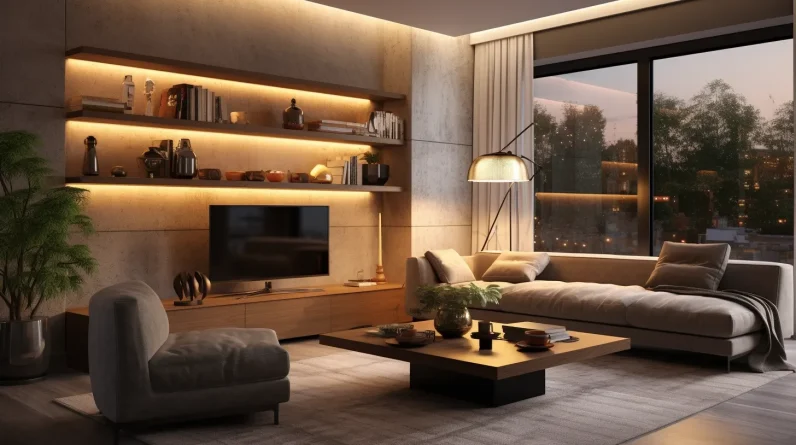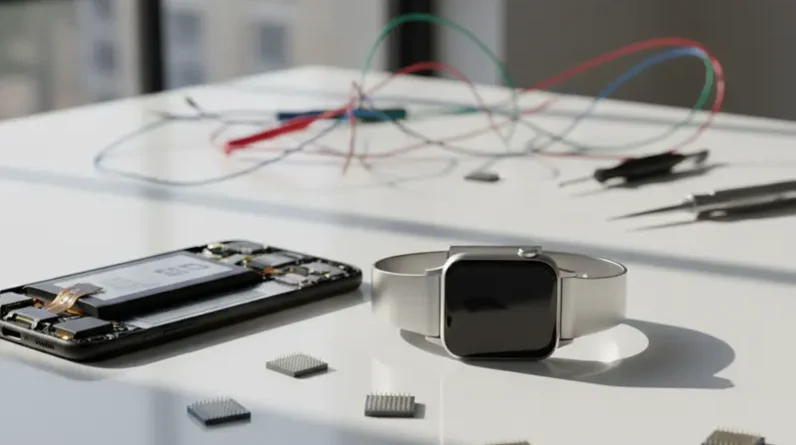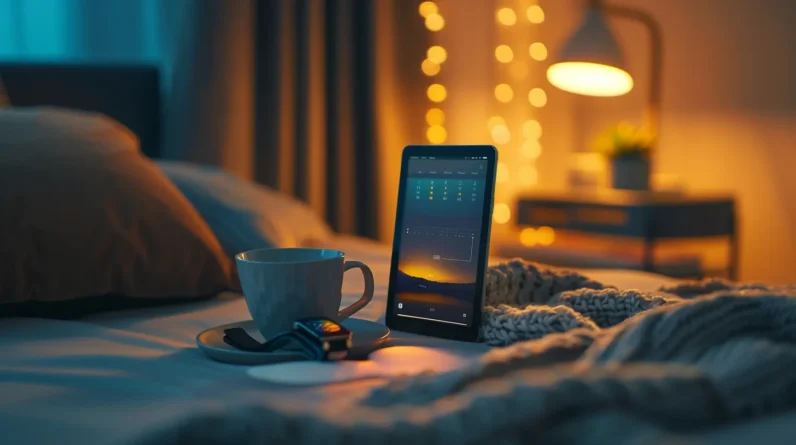
Technology continues to shape the way we live, it’s ironic that one of the most overlooked aspects of home design is often the lighting. However, with the rise of smart home technology, the art of lighting design is undergoing a revolution.
No longer just about illuminating a space, smart home lighting offers a creative, knowledgeable, and detail-oriented approach to enhancing ambiance, maximizing energy efficiency, and integrating seamlessly into your home automation system.
Join us as we explore the art of smart home lighting design and unlock the freedom to illuminate your space in new and exciting ways.
Key Takeaways
– Lighting plays a significant role in creating ambiance and atmosphere in a space.
– Smart home lighting fixtures offer energy efficiency, convenience, and customization.
– Color temperature can be used to create different moods and enhance the desired atmosphere.
– Integrating smart lighting into a home automation system allows for customization, convenience, and energy efficiency.
The Importance of Lighting in Home Design
As we delve into the realm of smart home lighting design, it is crucial to understand the importance of lighting in overall home design. Lighting plays a significant role in creating the desired ambiance and atmosphere in a space. It has the power to transform a room, evoke emotions, and enhance the overall aesthetic appeal of a home. The psychology of lighting is a field that explores the impact of light on human behavior and emotions. It is widely recognized that lighting can affect mood, productivity, and even sleep patterns.
Natural light is an essential aspect of smart home lighting design. Natural light not only provides a sense of openness and connection to the outdoors but also has numerous health benefits. Exposure to natural light helps regulate our circadian rhythm, which in turn improves our sleep quality and overall well-being. It also reduces the reliance on artificial lighting, resulting in energy savings and a more sustainable home.
When designing a smart lighting system, it is important to consider the placement and intensity of light fixtures to ensure proper illumination and create the desired atmosphere. Dimmers and color-changing bulbs can be used to adjust the lighting to suit various activities and moods throughout the day. Smart lighting systems can also be integrated with other smart home devices, allowing for convenient control and automation.
Understanding the Basics of Smart Home Lighting
Efficiency and convenience are key considerations when delving into the basics of smart home lighting design. Smart home lighting fixtures offer a wide range of benefits that enhance the overall experience of illuminating your living space. These fixtures are not just ordinary light bulbs; they are equipped with advanced technology that allows you to control them remotely using your smartphone or voice commands.
With the touch of a button or a simple voice command, you can adjust the brightness, color, and even create personalized lighting scenes to suit your mood or activities.
One of the main benefits of smart lighting is energy efficiency. These fixtures are designed to be highly energy-efficient, using LED technology that consumes less power compared to traditional incandescent bulbs. This not only helps you reduce your electricity bills but also contributes to a greener environment.
In addition to energy efficiency, smart lighting also offers convenience. Imagine being able to turn on or off your lights from anywhere in your home, or even when you’re away. You can also schedule your lights to automatically turn on or off at specific times, creating an illusion of occupancy when you’re not home, enhancing security.
Smart lighting allows for customization and personalization. You can easily adjust the color and intensity of the light to create different atmospheres in your home. Whether you prefer a warm and cozy ambiance for a relaxing evening or a bright and vibrant setting for a party, smart lighting gives you the freedom to set the mood with just a few taps on your smartphone.
Creating Ambiance: Choosing the Right Color Temperature
The choice of the right color temperature is crucial in creating the desired ambiance for your smart home lighting design. Color temperature refers to the warmth or coolness of light, measured in Kelvin (K). It plays a significant role in setting the mood and atmosphere of a space.
Color psychology is an important consideration when selecting the right hues for different moods. Warm colors, such as reds and oranges, are often associated with energy, passion, and warmth. They can create a cozy and inviting atmosphere in living spaces or dining areas. On the other hand, cool colors like blues and greens are known for their calming and soothing effects, making them ideal for bedrooms or relaxation areas.
When it comes to enhancing productivity, optimizing lighting for workspaces and study areas is key. Cool white lights with a higher color temperature, around 5000K to 6500K, are often recommended for these areas. This type of lighting mimics natural daylight and can help improve focus, alertness, and productivity.
Maximizing Energy Efficiency With Smart Lighting
Smart lighting systems offer numerous benefits, including cost savings and environmental sustainability. By implementing energy saving techniques and optimizing lighting schedules, homeowners can maximize the energy efficiency of their smart lighting systems.
Here are three key strategies to achieve this:
1. Motion Sensors: Installing motion sensors in rooms can help conserve energy by automatically turning off lights when no one is present. This eliminates the need for manual control and prevents lights from being left on unnecessarily.
2. Dimmers and Timers: Smart lighting systems allow for easy control of dimmers and timers, enabling users to adjust light intensity and duration based on their specific needs. By dimming lights or setting timers to turn off lights during daylight hours, energy consumption can be reduced significantly.
3. Integration with Natural Light: Smart lighting systems can be programmed to work in harmony with natural light. By incorporating sensors that detect ambient light levels, the system can automatically adjust the brightness of artificial lighting to compensate for changes in natural light, saving energy while maintaining optimal illumination.
To further optimize energy efficiency, homeowners can schedule lighting to correspond with daily routines. For example, programming lights to turn on gradually in the morning and dimming them in the evening can create a more energy-efficient lighting schedule that aligns with natural circadian rhythms.
Integrating Smart Lighting Into Your Home Automation System
With the increasing popularity of home automation systems, integrating smart lighting has become an essential step towards creating a seamless and technologically advanced living environment. Smart lighting systems allow for seamless integration with other home automation devices, making it easier than ever to control and customize your home lighting. Whether you want to dim the lights for a movie night or set the perfect ambiance for a dinner party, smart lighting can be easily tailored to your preferences.
One of the key benefits of integrating smart lighting into your home automation system is the ability to customize your lighting settings for different rooms. With smart lighting, you can personalize the brightness, color, and even the timing of your lights to suit each room’s specific needs. For example, you can set your bedroom lights to gradually brighten in the morning to simulate a natural sunrise, or program your living room lights to turn on automatically when you enter the room.
In addition to customization options, smart lighting systems also offer convenience and energy efficiency. With the ability to control your lights remotely through a smartphone app or voice command, you can easily turn off lights when they are not in use, reducing energy consumption and saving money on your electricity bill.
Frequently Asked Questions (FAQs)
What Are Some Common Mistakes to Avoid When Designing a Smart Home Lighting System?
When designing a smart home lighting system, it is important to avoid common mistakes that can hinder its success. By following tips for success, such as considering lighting needs, avoiding overcomplication, and ensuring proper installation, a well-designed smart home lighting system can provide the desired freedom and convenience.
How Can I Control the Brightness and Color Temperature of My Smart Lights?
Controlling the brightness and color temperature of smart lights is crucial for creating the desired ambiance in a smart home. By selecting the appropriate smart bulbs and utilizing the features provided by smart lighting systems, users can easily adjust these settings to their liking.
Are There Any Compatibility Issues Between Different Smart Home Lighting Brands?
Compatibility issues between different smart home lighting brands can arise due to differences in communication protocols or software. These issues can affect the functionality and control of the lighting system, leading to potential security concerns. Troubleshooting common smart home lighting issues can help mitigate these compatibility challenges.
Can Smart Home Lighting Systems Be Easily Integrated With Voice Assistants Like Alexa or Google Home?
Integrating smart home lighting with voice assistants like Alexa or Google Home is a seamless process, allowing users to control their lighting through simple voice commands. Troubleshooting common issues can ensure a smooth experience.
Is It Possible to Schedule Lighting Scenes or Automate Lighting Based on Occupancy or Time of Day With Smart Home Lighting Systems?
Yes, it is possible to schedule lighting scenes and automate lighting based on occupancy or time of day with smart home lighting systems. This allows for convenient and efficient lighting control, enhancing the overall smart home experience.
Conclusion
In conclusion, smart home lighting design is an art that combines functionality, ambiance, and energy efficiency.
Just as a skilled painter blends colors on a canvas to create a masterpiece, a well-designed lighting system can transform a home into a work of art.
By understanding the basics of smart lighting and integrating it into a home automation system, homeowners can achieve the perfect balance of convenience, comfort, and style.
Like a symphony conductor orchestrating the perfect harmony, smart lighting brings a sense of balance and harmony to any living space.







